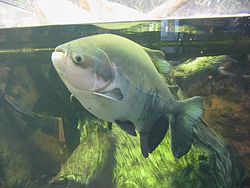Pacus
| Pacu | |
|---|---|
 |
|
| Large pacu at the Shedd Aquarium | |
| Scientific classification | |
| Kingdom: | Animalia |
| Phylum: | Chordata |
| Class: | Actinopterygii |
| Order: | Characiformes |
| Family: | Serrasalmidae |
Pacu (Portuguese pronunciation: [paˈku]) is a common name used to refer to several species of omnivorous South American freshwater serrasalmid fish that are related to the piranha. Pacu and piranha do not have similar teeth, the main difference being jaw alignment; piranha have pointed, razor-sharp teeth in a pronounced underbite, whereas pacu have squarer, straighter teeth, which are uncannily similar to human teeth, and a less severe underbite, or a slight overbite. Pacu, unlike piranha, mainly feed on plant material and not flesh or scales. Additionally, the pacu can reach much larger sizes than piranha, at up to 1.08 m (3.5 ft) in total length and 40 kg (88 lb) in weight.
The common name pacu is generally applied to fish classified under the following genera. Among these, genera marked with a star* contain species where commonly used English names include the word pacu.
Each of these groups contain one or more separate species. For example, the fish often found in pet stores known as the black pacu and red-bellied pacu typically belong to the species Colossoma macropomum and Piaractus brachypomus, respectively. A species popular among fish farmers is Piaractus mesopotamicus, also known as Paraná River pacu or small-scaled pacu.
Pacu is a term of Brazilian Indian/Guaraní origin. When the large fish of the Colossoma genus entered the aquarium trade in the U.S. and other countries, they were labeled pacu. In the Brazilian Amazon, the term pacu is generally reserved to smaller and medium-sized fish in the Metynnis, Mylossoma, Mylesinus and Myleus genera. Colossoma macropomum are known as tambaqui, whereas Piaractus brachypomus is known as pirapitinga. In Peru, both of the species (Colossoma macropomum and Piaractus brachypomum) are called pacú and gamitana. Piaractus mesopotamicus of the Paraná-Paraguay basin is also called pacú in Paraguay and Argentina.
...
Wikipedia
